Physical and Mechanical Properties of Novel Porous Ecological Concrete Based on Magnesium Phosphate Cement
Abstract
:1. Introduction
2. Materials and Methods
3. Results and Analysis
3.1. MPC
3.1.1. Effect of P/M on Alkalinity and Compressive Strength
3.1.2. Effect of Mineral Admixture on Alkalinity and Compressive Strength
3.1.3. Pore Structure
3.1.4. XRD Analysis
3.1.5. SEM Observation
3.2. Porous Ecological Concrete Based on MPC
3.2.1. Effect of Paste Aggregate Ratio on the Void Ratio and Compressive Strength
3.2.2. Effect of Mineral Admixtures on the Void Ratio and Compressive Strength
4. Plant-Growing Verification of Porous Ecological Concrete
5. Conclusions
- (1)
- With the decrease of P/M, the alkalinity of the MPC gradually increased; however, the pH values were still much lower than the OPC. The compressive strength of MPC reached the maximum value of 49.2 MPa when P/M was 1/4.
- (2)
- The alkalinity and compressive strength of MPC increased with the addition of FA and GBFS, and the GBFS showed more significant effects on alkalinity and compressive strength than that of FA.
- (3)
- With the increase of the paste aggregate ratio, the void ratio of porous concrete gradually decreased from 37.3% to 30.8%, whereas the compressive strength gradually increased from 5.23 MPa to 6.12 MPa at 28 days. The compressive strength of porous concrete also increased with the addition of 20% FA and GBFS.
- (4)
- The seeds planted in the MPC-based porous ecological concrete began to germinate after one week and grew better than those in the OPC-based ecological concrete. Thus, the MPC-based porous ecological concrete showed feasibility in ecological rehabilitation projects.
- (5)
- At present, the setting time and cost of MPC-based ecological concrete are the main problems limiting its large-scale application. In the future, further research should be conducted in the field of research and development of environment-friendly retarders and the replacement of low-cost raw materials (such as recycled aggregate).
Author Contributions
Funding
Institutional Review Board Statement
Informed Consent Statement
Data Availability Statement
Conflicts of Interest
References
- Monteiro, P.J.M.; Miller, S.A.; Horvath, A. Towards sustainable concrete. Nat. Mater. 2017, 16, 698–699. [Google Scholar] [CrossRef] [PubMed]
- Ma, H.; Wu, Z.; Zhang, J.; Yu, H.; Liang, L. Uniaxial compressive properties of ecological concrete: Experimental and three-dimensional (3D) mesoscopic investigation. Constr. Build. Mater. 2021, 278, 121034. [Google Scholar] [CrossRef]
- Shen, W.; Liu, Y.; Wu, M.; Zhang, D.; Xiong, X. Ecological carbonated steel slag pervious concrete prepared as a key material of sponge city. J. Clean. Prod. 2020, 256, 120244. [Google Scholar] [CrossRef]
- Jang, J.G.; Ahn, Y.B.; Souri, H.; Lee, H.K. A novel eco-friendly porous concrete fabricated with coal ash and geopolymeric binder: Heavy metal leaching characteristics and compressive strength. Constr. Build. Mater. 2015, 79, 173–181. [Google Scholar] [CrossRef]
- Arias-Erazo, J.; Villaquirán-Caicedo, M.A.; Goyes, C.E. Ecological light transmiting concrete made from glass waste and acrylic sheets. Constr. Build. Mater. 2021, 304, 124644. [Google Scholar] [CrossRef]
- Kim, H.H.; Kim, C.S.; Jeon, J.H.; Park, C.G. Effects on the Physical and Mechanical Properties of Porous Concrete for Plant Growth of Blast Furnace Slag, Natural Jute Fiber, and Styrene Butadiene Latex Using a Dry Mixing Manufacturing Process. Materials 2016, 9, 84. [Google Scholar] [CrossRef] [PubMed]
- Kong, J.; Cong, G.; Ni, S.; Sun, J.; Guo, C.; Chen, M.; Quan, H. Recycling of waste oyster shell and recycled aggregate in the porous ecological concrete used for artificial reefs. Constr. Build. Mater. 2022, 323, 126447. [Google Scholar] [CrossRef]
- Kim, H.H.; Kim, C.S.; Jeon, J.H.; Park, C.G. Physical, Mechanical Properties and Freezing and Thawing Resistance of Non-Cement Porous Vegetation Concrete Using Non-Sintering Inorganic Binder. J. Korean Soc. Agric. Eng. 2014, 56, 37–44. [Google Scholar]
- Chindaprasirt, P.; Hatanaka, S.; Mishima, N.; Yuasa, Y. Effects of binder strength and aggregate size on the compressive strength and void ratio of porous concrete. Int. J. Min. Met. Mater. 2009, 16, 714–719. [Google Scholar]
- Yan, X.; Gong, C.; Wang, S.; Lu, L. Effect of aggregate coating thickness on pore structure features and properties of porous ecological concrete. Mag. Concr. Res. 2013, 65, 962–969. [Google Scholar] [CrossRef]
- Lian, C.; Zhuge, Y.; Beecham, S. The relationship between porosity and strength for porous concrete. Constr. Build. Mater. 2011, 25, 4294–4298. [Google Scholar] [CrossRef]
- Vollpracht, A.; Lothenbach, B.; Snellings, R.; Haufe, J. The pore solution of blended cements: A review. Mater. Struct. 2016, 49, 3341–3367. [Google Scholar] [CrossRef]
- Geng, G.; Li, J.; Yu, Y.S.; Shapiro, D.A.; Kilcoyne, D.A.L.; Monteiro, P.J.M. Nanometer-Resolved Spectroscopic Study Reveals the Conversion Mechanism of CaO center dot Al2O3 center dot 10H2O to 2CaO center dot Al2O3 center dot 8H2O and 3CaO center dot Al2O3 center dot 6H2O at an Elevated Temperature. Cryst. Growth Des. 2017, 17, 4246–4253. [Google Scholar] [CrossRef] [Green Version]
- Myers, R.J.; Provis, J.L.; Lothenbach, B. Composition–solubility–structure relationships in calcium (alkali) aluminosilicate hydrate (C-(N, K-) ASH). Dalton Trans. 2015, 44, 13530–13544. [Google Scholar] [CrossRef] [PubMed] [Green Version]
- Hargis, C.W.; Kirchheim, A.P.; Monteiro, P.J.M.; Gartner, E.M. Early age hydration of calcium sulfoaluminate (synthetic ye’elimite,) in the presence of gypsum and varying amounts of calcium hydroxide. Cem. Concr. Res. 2013, 48, 105–115. [Google Scholar] [CrossRef]
- Yan, X.; Lu, L.; Gong, C.; Wang, S. Preparation and Properties of Sulphoaluminate Cementitious Materials with Low Alkalinity. Appl. Mech. Mater. 2012, 174–177, 1164–1167. [Google Scholar] [CrossRef]
- Calvo, J.L.G.; Hidalgo, A.; Alonso, C.; Luco, L.F. Development of low-pH cementitious materials for HLRW repositories: Resistance against ground waters aggression. Cem. Concr. Res. 2010, 8, 1290–1297. [Google Scholar] [CrossRef]
- Ortaboy, S.; Li, J.; Geng, G.; Myers, R.J.; Monteiro, P.J.M.; Maboudian, R.; Carraro, C. Effects of CO2 and temperature on the structure and chemistry of C–(A–) S–H investigated by Raman spectroscopy. RSC Adv. 2017, 7, 48925–48933. [Google Scholar] [CrossRef] [Green Version]
- Hargis, C.W.; Lothenbach, B.; Müller, C.J.; Winnefeld, F. Carbonation of calcium sulfoaluminate mortars. Cem. Concr. Comp. 2017, 80, 123–134. [Google Scholar] [CrossRef]
- Šauman, Z. Effect of CO2 on porous concrete. Cem. Concr. Res. 1972, 2, 541–549. [Google Scholar] [CrossRef]
- Walling, S.A.; Provis, J.L. Magnesia-Based Cements: A Journey of 150 Years, and Cements for the Future? Chem. Rev. 2016, 116, 4170–4204. [Google Scholar] [CrossRef] [PubMed] [Green Version]
- Ma, H.; Xu, B.; Liu, J.; Pei, H.; Li, Z. Effects of water content, magnesia-to-phosphate molar ratio and age on pore structure, strength and permeability of magnesium potassium phosphate cement paste. Mater. Des. 2014, 64, 497–502. [Google Scholar] [CrossRef]
- Fan, S.; Chen, B. Experimental research of water stability of magnesium alumina phosphate cements mortar. Constr. Build. Mater. 2015, 94, 164–171. [Google Scholar] [CrossRef]
- Fan, S.; Chen, B. Experimental study of phosphate salts influencing properties of magnesium phosphate cement. Constr. Build. Mater. 2014, 65, 480–486. [Google Scholar] [CrossRef]
- Manso, S.; Calvo, M.A.; Belie, N.D.; Segura, I.; Aguado, A. Evaluation of natural colonisation of cementitious materials: Effect of bioreceptivity and environmental conditions. Sci. Total. Environ. 2015, 512–513, 444–453. [Google Scholar] [CrossRef] [Green Version]
- Manso, S.; Mestres, G.; Ginebra, M.P.; Belie, N.D.; Segura, I.; Aguado, A. Development of a low pH cementitious material to enlarge bioreceptivity. Constr. Build. Mater. 2014, 54, 485–495. [Google Scholar] [CrossRef]
- Manso, S.; Muynck, W.D.; Segura, I.; Aguado, A.; Steppe, K.; Boon, N.; Belie, N.D. Bioreceptivity evaluation of cementitious materials designed to stimulate biological growth. Sci. Total Environ. 2014, 481, 232–241. [Google Scholar] [CrossRef]
- Zárybnická, L.; Machotová, J.; Mácová, P.; Machová, D.; Viani, A. Design of polymeric binders to improve the properties of magnesium phosphate cement. Constr. Build. Mater. 2021, 290, 123202. [Google Scholar] [CrossRef]
- Qin, J.; Qian, J.; Dai, X.; You, C.; Ma, H.; Li, Z. Effect of water content on microstructure and properties of magnesium potassium phosphate cement pastes with different magnesia-to-phosphate ratios. J. Am. Ceram. Soc. 2021, 104, 2799–2819. [Google Scholar] [CrossRef]
- Li, J.; Zhang, W.; Monteiro, P.J. Mechanical properties of struvite-K: A high-pressure X-ray diffraction study. Cem. Concr. Res. 2020, 136, 106171. [Google Scholar] [CrossRef]
- Li, Y.; Shi, T.; Li, J. Effects of fly ash and quartz sand on water-resistance and salt-resistance of magnesium phosphate cement. Constr. Build. Mater. 2016, 105, 384–390. [Google Scholar] [CrossRef]
- Chong, L.; Yang, J.; Shi, C. Effect of curing regime on water resistance of magnesium–potassium phosphate cement. Constr. Build. Mater. 2017, 151, 43–51. [Google Scholar] [CrossRef]
- GB/T 17671-2021; Cement Mortar Strength Testing Method (ISO). China Standards Press: Beijing, China, 2021.
- GB/T 50081-2002; Standard Test Method for Mechanical Properties of Ordinary Concrete. China Academy of Building Research: Beijing, China, 2002.
- Li, Y.; Sun, J.; Chen, B. Experimental study of magnesia and M/P ratio influencing properties of magnesium phosphate cement. Constr. Build. Mater. 2014, 65, 177–183. [Google Scholar] [CrossRef]
- Li, Y.; Li, Y.; Shi, T.; Li, J. Experimental study on mechanical properties and fracture toughness of magnesium phosphate cement. Constr. Build. Mater. 2015, 96, 346–352. [Google Scholar] [CrossRef]
- Gardner, L.J.; Bernal, S.A.; Walling, S.A.; Corkhill, C.L.; Provis, J.L.; Hyatt, N.C. Characterisation of magnesium potassium phosphate cements blended with fly ash and ground granulated blast furnace slag. Cem. Concr. Res 2015, 74, 78–87. [Google Scholar] [CrossRef] [Green Version]
- Li, Y.; Li, J. Capillary tension theory for prediction of early autogenous shrinkage of self-consolidating concrete. Constr. Build. Mater. 2014, 53, 511–516. [Google Scholar] [CrossRef]
- Liang, L.; Yu, H.; Pan, Z. Preparation process and properties of porous ecological concrete. J. Wuhan Univ. Technol. 2010, 32, 256–260. [Google Scholar]
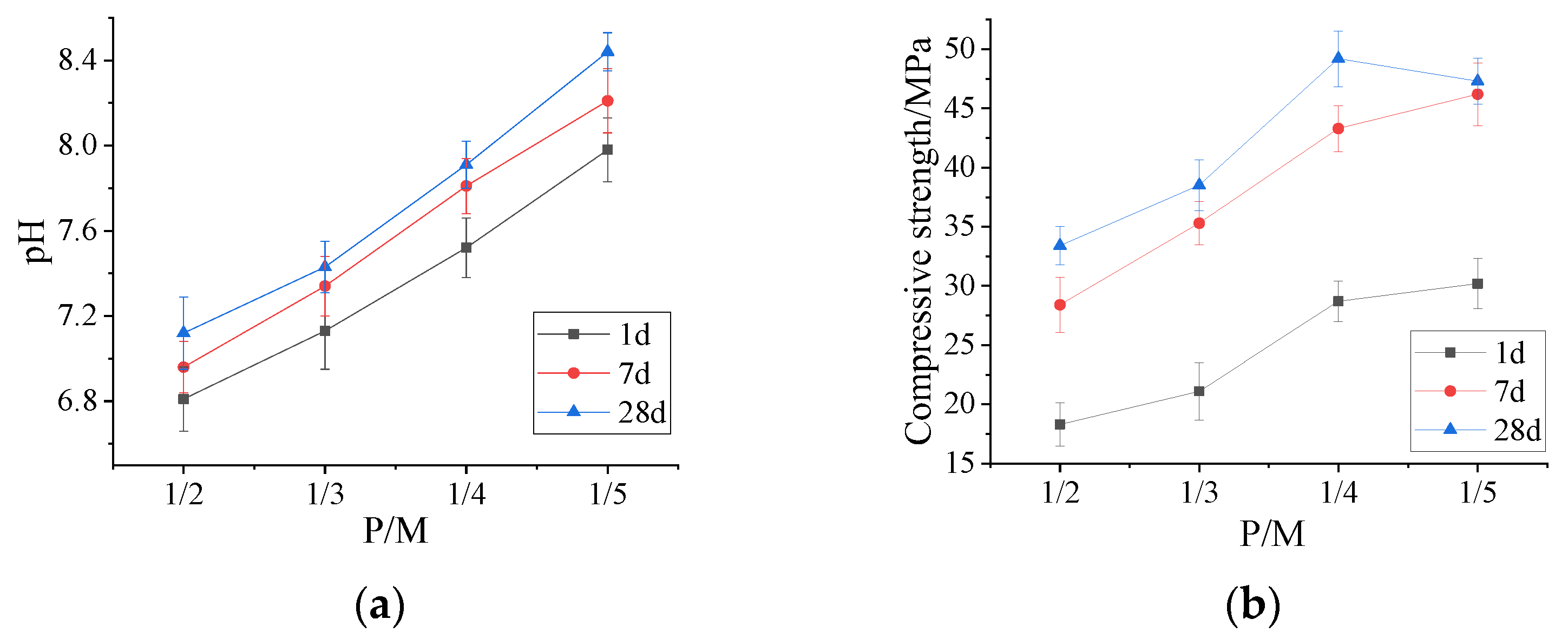
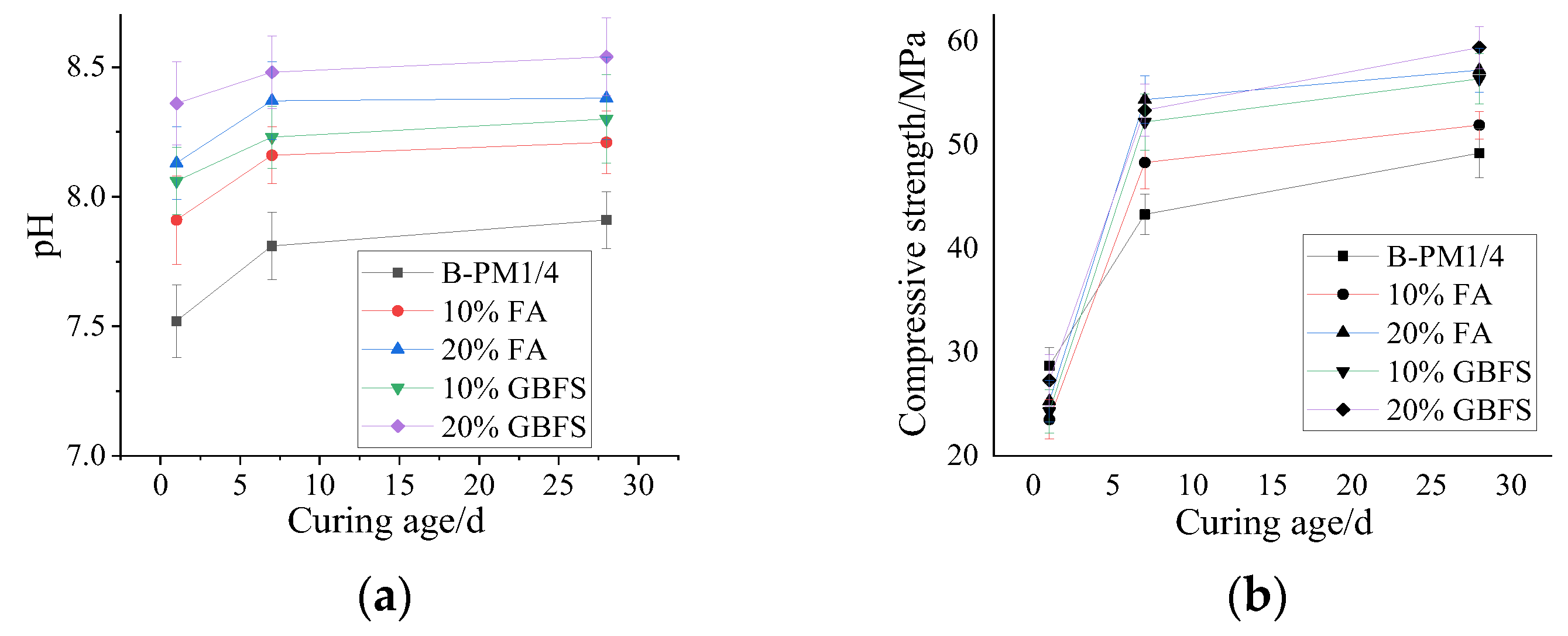
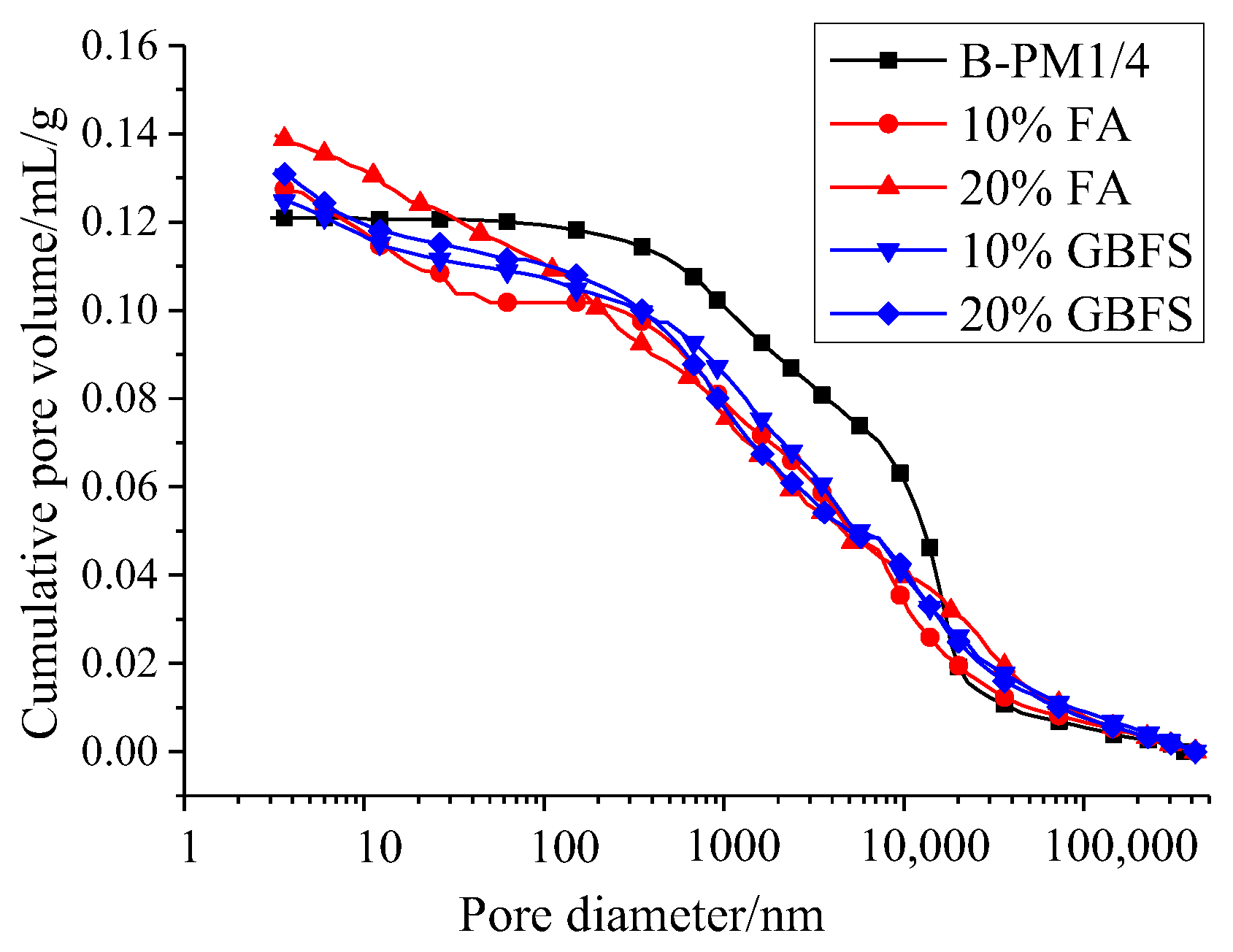
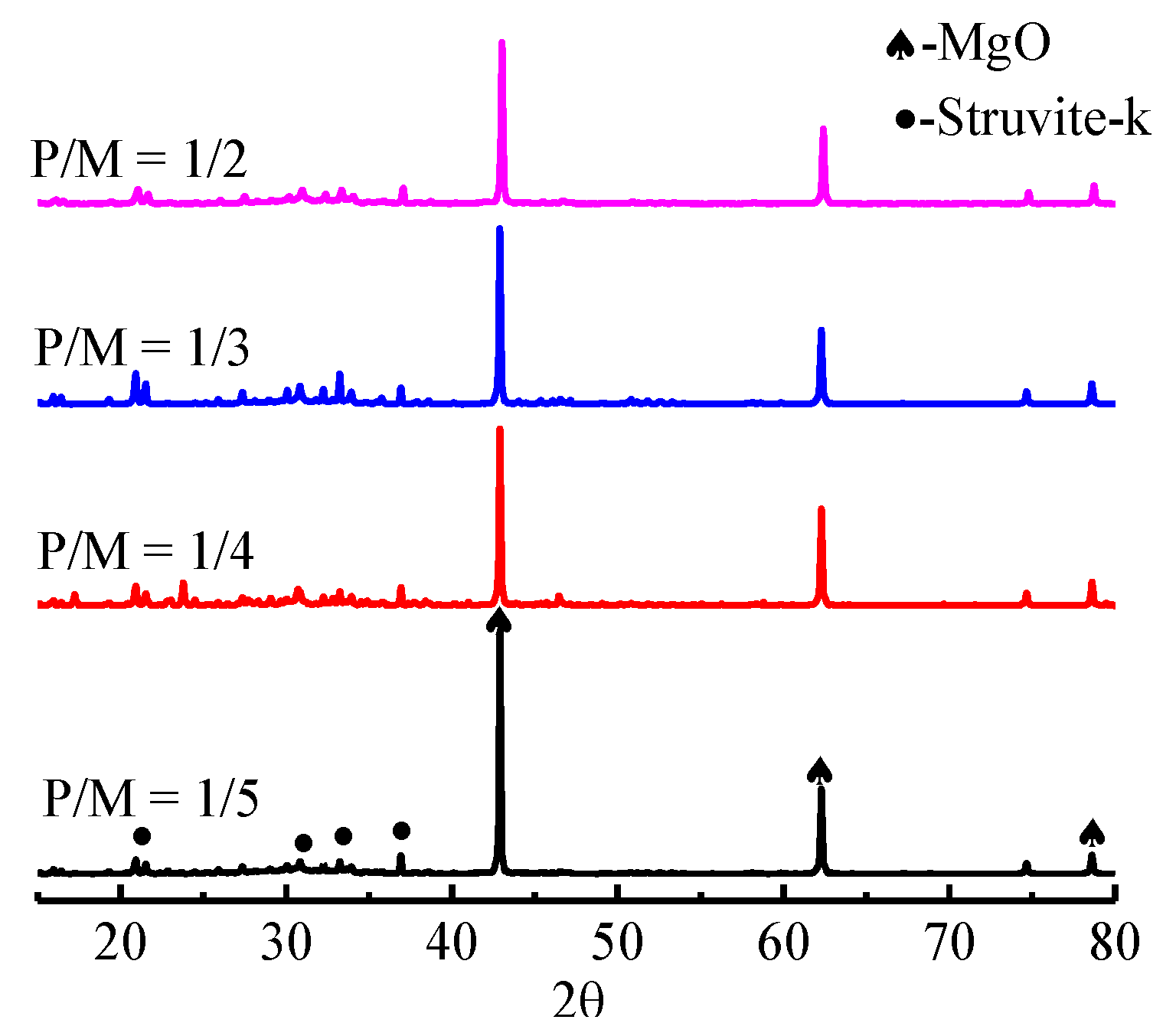
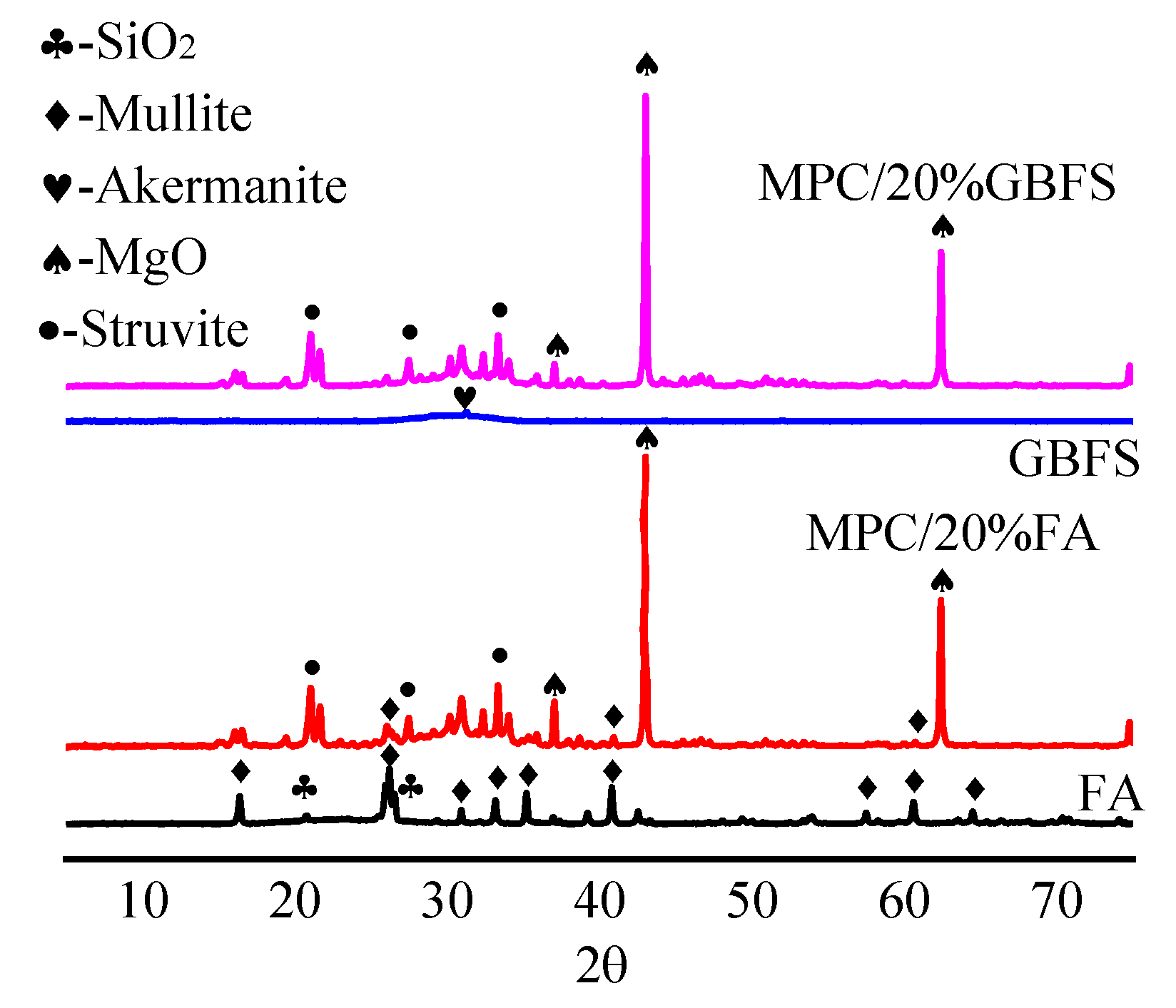

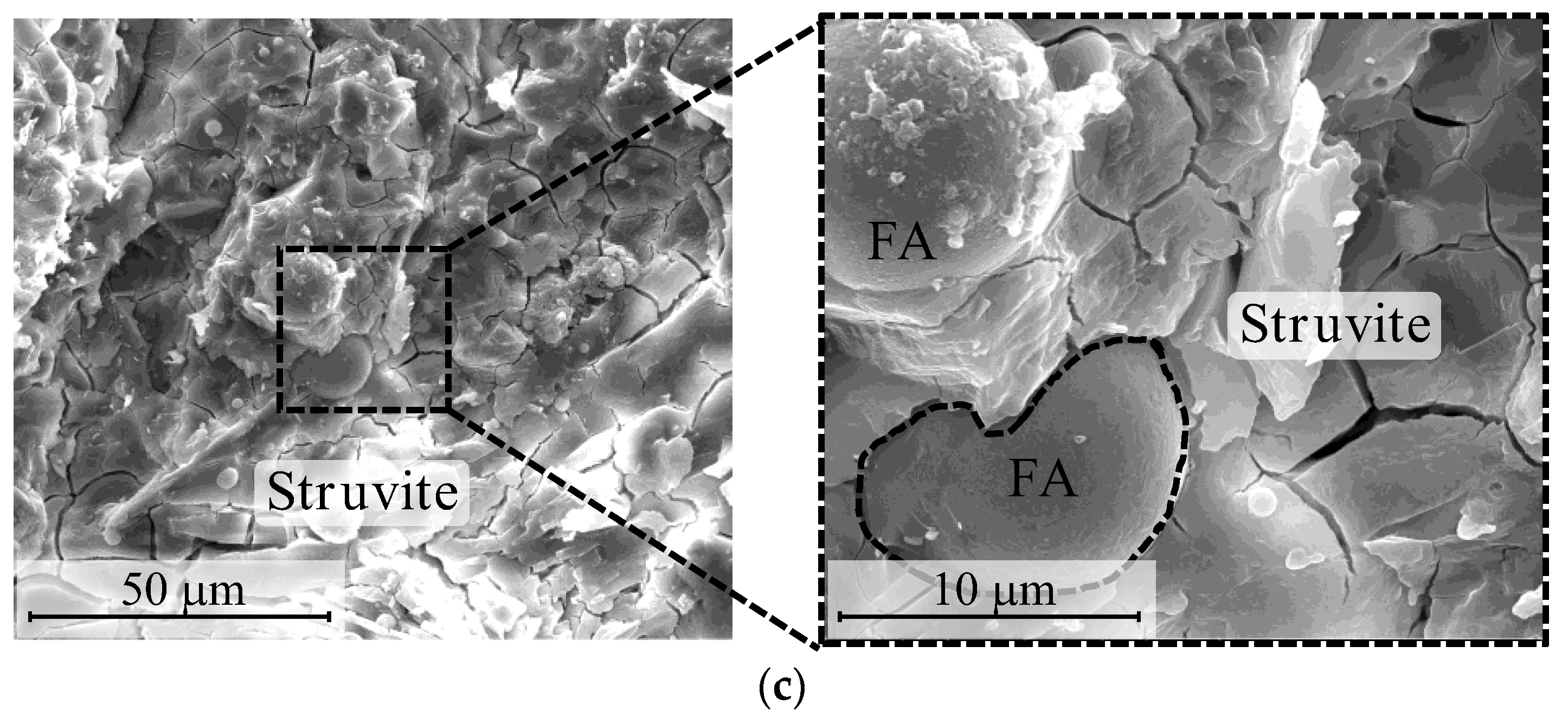

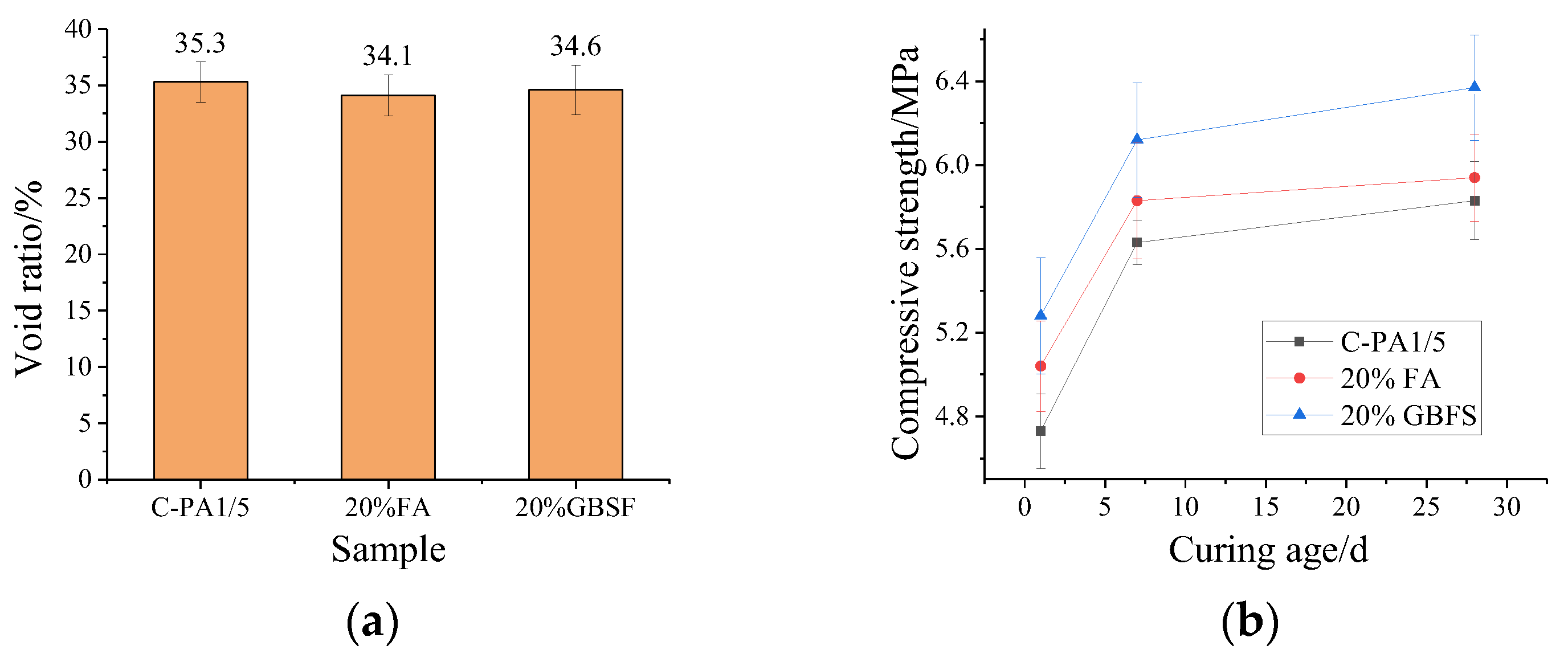

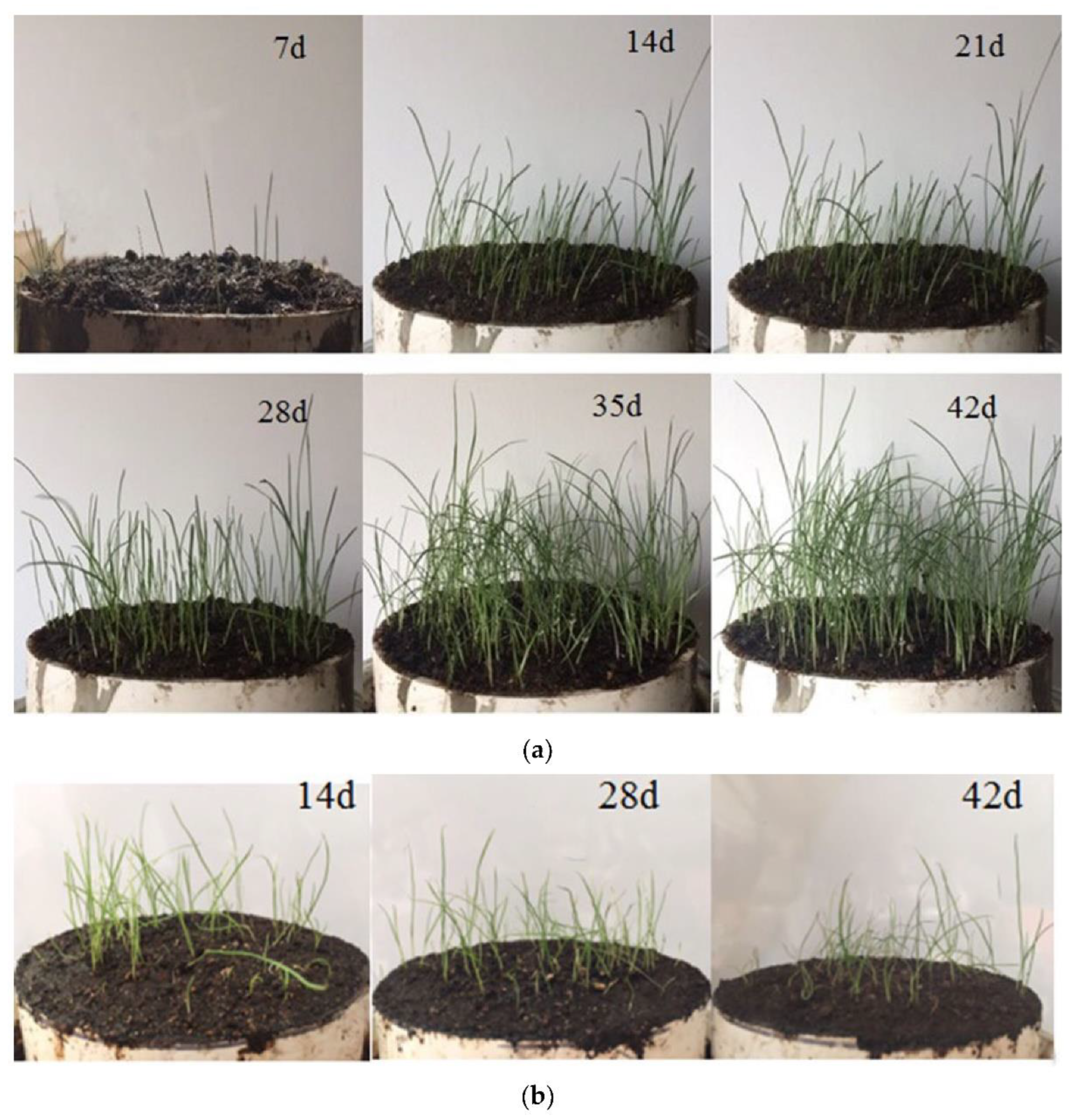
| Materials | MgO (%) | SiO2 (%) | Al2O3 (%) | CaO (%) | Fe2O3 (%) | TiO2 (%) | K2O (%) | SO3 (%) | Na2O (%) | Loss (%) | Specific Surface (m2/kg) | Density (g/cm3) |
|---|---|---|---|---|---|---|---|---|---|---|---|---|
| MgO | 92 | 4 | 1.4 | 1.6 | 1.3 | 0 | 0 | 0 | 0 | 0 | 805.9 | 3.46 |
| FA | 0.8 | 48.2 | 33.78 | 6.4 | 5.08 | 1.87 | 1 | 0.75 | 0.6 | 1.45 | 2558 | 2.31 |
| GBFS | 12 | 32.4 | 12.7 | 37 | 0.4 | 1.34 | 0.4 | 2.27 | 0.5 | 0.7 | 964 | 2.78 |
| No. | P/M | W/B | Borax/% | FA/% | GBFS/% |
|---|---|---|---|---|---|
| B-PM1/2 | 1/2 | 0.14 | 5 | ˗ | ˗ |
| B-PM1/3 | 1/3 | 0.14 | 5 | ˗ | ˗ |
| B-PM1/4 | 1/4 | 0.14 | 5 | ˗ | ˗ |
| B-PM1/5 | 1/5 | 0.14 | 5 | ˗ | ˗ |
| B-PM1/4-FA10 | 1/4 | 0.14 | 5 | 10 | ˗ |
| B-PM1/4-FA20 | 1/4 | 0.14 | 5 | 20 | ˗ |
| B-PM1/4-FS10 | 1/4 | 0.14 | 5 | ˗ | 10 |
| B-PM1/4-FS20 | 1/4 | 0.14 | 5 | ˗ | 20 |
| No. | P/M | FA% | GBFS% | Borax/% | W/B | Paste Aggregate Ratio |
|---|---|---|---|---|---|---|
| C-PA1/6 | 1/4 | ˗ | ˗ | 5 | 0.14 | 1/6 |
| C-PA1/5 | 1/4 | ˗ | ˗ | 5 | 0.14 | 1/5 |
| C-PA1/4 | 1/4 | ˗ | ˗ | 5 | 0.14 | 1/4 |
| C-PA1/5-FA20 | 1/4 | 20 | ˗ | 5 | 0.14 | 1/5 |
| C-PA1/5-FS20 | 1/4 | ˗ | 20 | 5 | 0.14 | 1/5 |
| Specimens | pH | Compressive Strength (MPa) | ||||
|---|---|---|---|---|---|---|
| 1d | 7d | 28d | 1d | 7d | 28d | |
| B-PM1/2 | 6.81 (0.15) | 6.96 (0.12) | 7.12 (0.17) | 18.3 (1.82) | 28.4 (2.32) | 33.4 (1.63) |
| B-PM1/3 | 7.13 (0.18) | 7.34 (0.14) | 7.43 (0.12) | 21.1 (2.42) | 35.3 (1.82) | 38.5 (2.14) |
| B-PM1/4 | 7.52 (0.14) | 7.81 (0.13) | 7.91 (0.11) | 28.7 (1.73) | 43.3 (1.94) | 49.2 (2.36) |
| B-PM1/5 | 7.98 (0.15) | 8.21 (0.15) | 8.44 (0.09) | 30.2 (2.13) | 46.2 (2.64) | 47.3 (1.93) |
| B-PM1/4-FA10 | 7.91 (0.17) | 8.16 (0.11) | 8.21 (0.12) | 23.51 (1.89) | 48.3 (2.57) | 51.90 (1.33) |
| B-PM1/4-FA20 | 8.13 (0.14) | 8.37 (0.15) | 8.38 (0.16) | 25.27 (1.99) | 54.37 (2.27) | 57.21 (2.13) |
| B-PM1/4-FS10 | 8.06 (0.13) | 8.23 (0.12) | 8.3 (0.17) | 24.29 (2.09) | 52.21 (2.71) | 56.37 (2.42) |
| B-PM1/4-FS20 | 8.36 (0.16) | 8.48 (0.14) | 8.54 (0.15) | 27.29 (2.49) | 53.34 (2.52) | 59.38 (2.04) |
| Sample | Pore Volume/mL/g | Pore Volume Distribution/% | |||
|---|---|---|---|---|---|
| <0.01 μm | 0.01–0.1 μm | 0.1–1 μm | >1 μm | ||
| B-PM1/4 | 0.121 | 0.02 | 0.17 | 1.83 | 10.08 |
| B-PM1/4-FA10 | 0.1278 | 1.01 | 1.61 | 2.23 | 7.93 |
| B-PM1/4-FA20 | 0.1394 | 0.76 | 2.19 | 4.68 | 6.31 |
| B-PM1/4-FS10 | 0.125 | 0.82 | 0.87 | 2.11 | 8.13 |
| B-PM1/4-FS20 | 0.1317 | 1.22 | 0.91 | 3.27 | 7.77 |
Publisher’s Note: MDPI stays neutral with regard to jurisdictional claims in published maps and institutional affiliations. |
© 2022 by the authors. Licensee MDPI, Basel, Switzerland. This article is an open access article distributed under the terms and conditions of the Creative Commons Attribution (CC BY) license (https://creativecommons.org/licenses/by/4.0/).
Share and Cite
Zhao, S.; Zhang, D.; Li, Y.; Gao, H.; Meng, X. Physical and Mechanical Properties of Novel Porous Ecological Concrete Based on Magnesium Phosphate Cement. Materials 2022, 15, 7521. https://doi.org/10.3390/ma15217521
Zhao S, Zhang D, Li Y, Gao H, Meng X. Physical and Mechanical Properties of Novel Porous Ecological Concrete Based on Magnesium Phosphate Cement. Materials. 2022; 15(21):7521. https://doi.org/10.3390/ma15217521
Chicago/Turabian StyleZhao, Shuaiyu, Dongpo Zhang, Yaqiang Li, Hang Gao, and Xinmiao Meng. 2022. "Physical and Mechanical Properties of Novel Porous Ecological Concrete Based on Magnesium Phosphate Cement" Materials 15, no. 21: 7521. https://doi.org/10.3390/ma15217521





